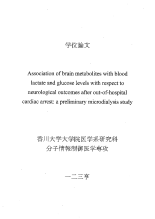Association of brain metabolites with blood lactate and glucose levels with respect to neurological outcomes after out-of-hospital cardiac arrest : a preliminary microdialysis study
この論文にアクセスする
著者
書誌事項
- タイトル
-
Association of brain metabolites with blood lactate and glucose levels with respect to neurological outcomes after out-of-hospital cardiac arrest : a preliminary microdialysis study
- 著者名
-
一二三, 亨
- 学位授与大学
-
香川大学
- 取得学位
-
博士(医学)
- 学位授与番号
-
甲第669号
- 学位授与年月日
-
2017-03-24
注記・抄録
AimOut-of-hospital cardiac arrest (OHCA) is associated with poor prognosis. Cerebral microdialysis (CMD) is an efficient sampling technique to detect neurochemical changes in brain interstitial tissue. In this retrospective study, we hypothesised that there are different CMD levels between patients with favourable and unfavourable neurological outcomes.
MethodsData of patients with OHCA admitted to Kagawa University Hospital and administered therapeutic hypothermia (TH) were collected. Using a CMD probe, extracellular glucose, lactate and pyruvate levels were measured hourly along with intracranial perfusion pressure (ICP) and cerebral perfusion pressure (CPP) for the initial 72 h during TH. The lactate/pyruvate (LP) ratio was calculated. Patients were divided into favourable [Glasgow–Pittsburgh cerebral performance category 1–2 at 30 days after cardiac arrest] or unfavourable neurological outcome groups. CMD biochemical markers and blood lactate and glucose levels were compared between two groups.
ResultsTen patients were included. ICP was significantly higher in the unfavourable than in the favourable neurological outcome group; there were no significant differences with respect to CPP. The CMD LP ratio in the unfavourable outcome group progressively increased; significant differences were observed on days 2, 3 and 4 (p < 0.01). Significant differences in blood lactate levels were observed between the groups only on day 3.5. CMD and blood glucose levels were higher in the unfavourable than in the favourable outcome group during TH.
ConclusionThe association of CMD levels with long-term outcomes would be better defined in a large randomised prospective study.
Aim Out-of-hospital cardiac arrest (OHCA) is associated with poor prognosis. Cerebral microdialysis (CMD) is an efficient sampling technique to detect neurochemical changes in brain interstitial tissue. In this retrospective study, we hypothesised that there are different CMD levels between patients with favourable and unfavourable neurological outcomes.
Methods Data of patients with OHCA admitted to Kagawa University Hospital and administered therapeutic hypothermia (TH) were collected. Using a CMD probe, extracellular glucose, lactate and pyruvate levels were measured hourly along with intracranial perfusion pressure (ICP) and cerebral perfusion pressure (CPP) for the initial 72 h during TH. The lactate/pyruvate (LP) ratio was calculated. Patients were divided into favourable [Glasgow–Pittsburgh cerebral performance category 1–2 at 30 days after cardiac arrest] or unfavourable neurological outcome groups. CMD biochemical markers and blood lactate and glucose levels were compared between two groups.
Results Ten patients were included. ICP was significantly higher in the unfavourable than in the favourable neurological outcome group; there were no significant differences with respect to CPP. The CMD LP ratio in the unfavourable outcome group progressively increased; significant differences were observed on days 2, 3 and 4 (p < 0.01). Significant differences in blood lactate levels were observed between the groups only on day 3.5. CMD and blood glucose levels were higher in the unfavourable than in the favourable outcome group during TH.
Conclusion The association of CMD levels with long-term outcomes would be better defined in a large randomised prospective study.
